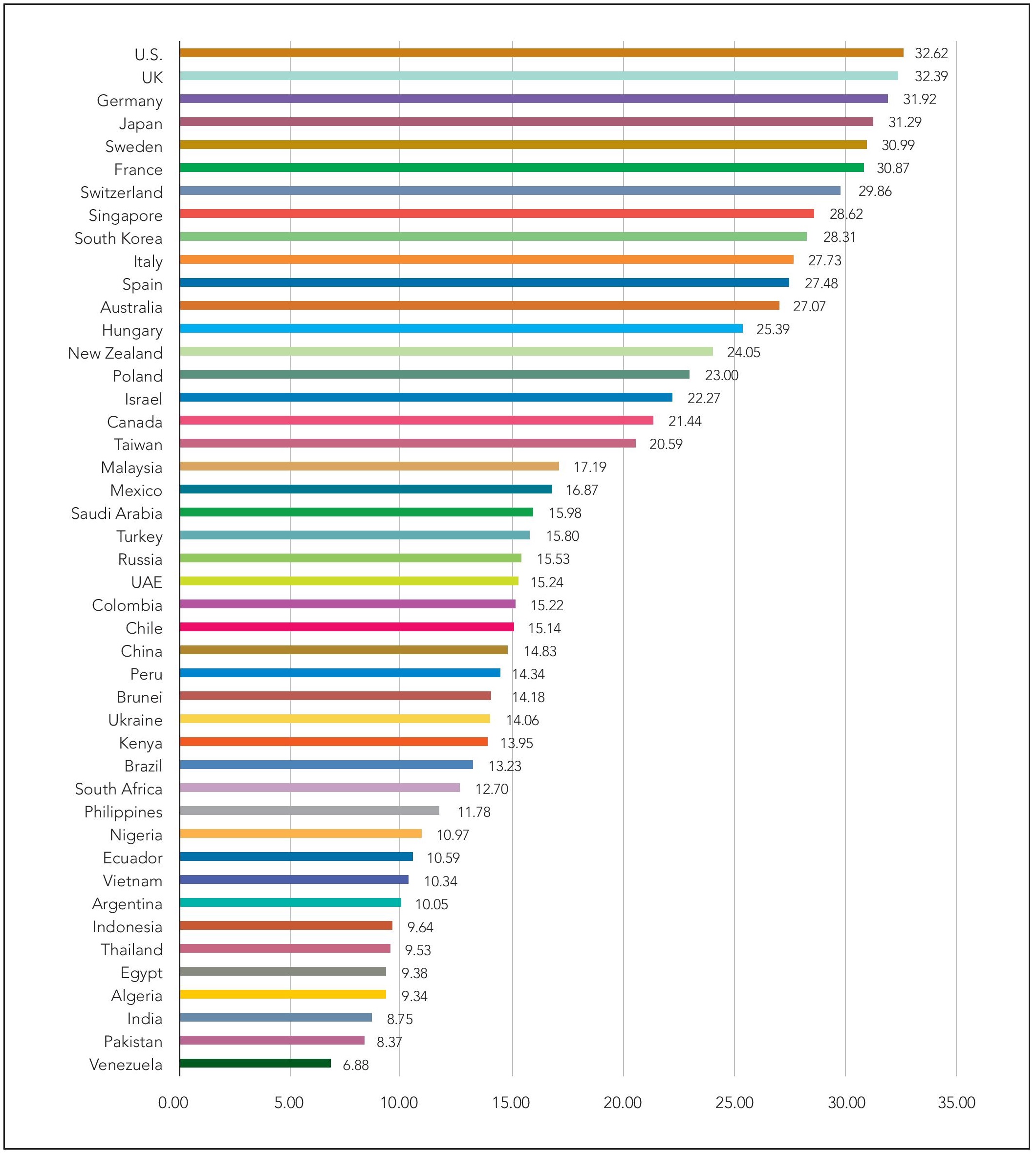Introduction What is Artificial Intelligence? Creating computer systems capable of carrying out activities that need…
India’s time to delve into IP laws
Shireen Shukla, legal intern at Kkurana & Khurana, probes the recent International IP Index report, released by U.S. Chamber of Commerce, where India stood at 43rd position, out of 45 countries.
On 8th February, 2017 U.S. Chamber of Commerce released its 5th annual International IP Index, “The Roots of Innovation,” rating 45 world economies on patents, trademarks, copyright, trade secrets, enforcement, and international treaties with the aim to provide both, an IP report card for the world and a guidebook for policymakers seeking to bolster economic growth and innovation.
It is an undeniable fact that protection of intellectual property serves dual role in the economic growth of a country. Where on one hand it promotes innovation by providing legal protection of inventions, on the other it may retard catch-up and learning by restricting the diffusion of innovations. Therefore a sounder IPR protection in a country encourages technology development and technology transfer from developed to least developed countries. Countries that would demonstrate a commitment to IP laws will only reap rewards.
Often we have seen that major companies and brands invest their money or open their outlets in another country only after seeing the soundness of their IP laws. This proves the role of IP laws and enforceability on the GDP of a country.
GIPC is leading a worldwide effort to champion intellectual property rights as vital to creating jobs, saving lives, advancing global economic growth, and generating breakthrough solutions to global challenges (Reddy, 2017). The Index ranked the IP systems of 45 countries. Where on one hand United States was ranked number 1, India and Pakistan were ranked 43 and 44 respectively.
Image Source: U.S. Chamber International IP Index: http://www.theglobalipcenter.com/ipindex2017-chart/#
Some major facts from the IP Index:
- A pack of global IP leaders emerged among the 2017 Index rankings, with the U.S., UK, Japan, and EU economies, ranked more closely together than ever.
- Canada signed the Comprehensive Economic and Trade Agreement (CETA), which raised the bar for life sciences IP protection.
- Russia introduced new forced localization measures.
- Japan’s score increased by 10% due to ratification of TPP and accession to the Index treaties.
- South Korea passed amendments to the Patent Law.
- Uncertainty around software patentability, Section 3(d) of the Patent Law, and High Court copyright decisions in India continue to present challenges.
- Indonesia’s Patent Law included a heightened efficacy requirement and outlawed second use claims.
- South Africa introduced new local procurement policies.
- UAE created a specialized IPR Court.
- Indian government issued the National Intellectual Property Rights Policy in 2016.
India announced the much-awaited National IPR Policy in May 2016. This act proved to be a positive attitude to foster the IP laws in India. The Policy is a boon for the IP industry as it provides constructive ways and methods to improve IP administration. The policy has enumerated the importance to educate Indian businesses about IP rights.
The Policy makers realizing the real issue in hand, addressed a number of important gaps in India’s national IP environment, which included the need for stronger enforcement of existing IP rights through the building of new state-level IP cells and investing more resources in existing enforcement agencies; reducing processing times for patent and trademark applications; as well as the need for introducing a legislative framework for the protection of trade secrets
Major developments and landmark judgments in Intellectual property laws since 2015:
- The Delhi high court on 7 October 2015, barred Mumbai-based Glenmark Pharmaceuticals Ltd from selling, distributing, marketing or exporting its anti-diabetes drugs Zita and Zita-Met,as they tentatively infringed the patent of US-based pharmaceuticals company Merck Sharp and Dohme Corp.
- In March, 2016, the Delhi High court in the case of Ericcson v. CCI for the first time ever, considered at how IP law interfaced with competition law. It allowed Competition Commission of India (CCI) to continue its investigation into anti-competitive practices by Ericsson regarding use of its SEP’s by other companies such as Micromax and Intex.
- National IPR Policy in 2016, released last year is entirely compliant with the WTO’s agreement on TRIPS.
- Examination time for trademarks has been reduced from 13 months to 8 months in the 2016 policy.
- Bombay HC passed a series of judgments cases (Phantm Films pvt, Ltd. v. CBFC & Anr; Eros International Media Ltd. & Another v. Bharat Sanchar Nigam Ltd.) laid down a strict agenda for the grant of John Doe orders leading to path breaking shift in the John Doe jurisprudence in India. The above-mentioned judgments are focused on balancing the interests of not just copyright holders but also the Internet users and innocent third party providers.
- The judgment by Bombay HC in Eros v. Telemax, is a pioneer that unwrapped the scope of arbitration of IP disputes arising out of licensing and other commercial transactions.
- In December 2016, the Delhi High Court in the case of Agri Biotech v. Registrar of Plant Varieties declared section 24(5) of the Plant Varieties Act unconstitutional. The court giving a momentous judgment stated that the section violates Article 14 as it gives unchecked powers to the Registrar. The registrar is not required to be from a legal background in order to grant interim relief to a breeder against any abusive third party act during the period its registration application is pending.This lead to arbitrary use of powers by the registrar.
Beside the above-mentioned developments and progressions, PM Narendra Modi’s “Make in India” initiative also aims to promoting foreign direct investment and implementing intellectual property rights. In these initiatives, the government has decided to improve the intellectual property rights for the benefit of innovators and creators by modernizing infrastructure, and using state of the art technology.
One of the most recent and effective change brought in the trademark rules was on 6th march 2017, where the number of trademark forms have been reduced from 74 to 8 with an aim of simplifying the process of trade mark applications. The new rules promote e-filling of the trademark applications. The fee for online filing of the application is 10 per cent lower than that of the physical filing.
Steps India can take to strengthen its IPR laws:
- India should implement speedy examination and registration procedures.
- It should take effective steps to achieve the target of one month (as stated in IPR policy 2016).
- The number of patent examiners and trademark offices should be increased to improve efficiency and disposal speed.
- Section 3(d) of India’s Patent Act 1970, relating to restrictions on patenting incremental changes should be amended. Norms relating ever greening should also be revised.
- A new and revised IPR laws and policies should be implemented so as to make it compatible with IPR laws of WIPO, TRIPS and other major dominant countries like US & UK
Every fiscal year, enormous time and money is being invested on R&D to improve the existing status of the Intellectual property laws in India, to bring it at par with the IP laws of US. We hope by following the above guidelines and following the National IPR Policy, India’s position improves in the next International IP Index 2017.
References :
- Prashant Reddy, The Press Release Journalism Around the GIPC IP Index, February 13, 2017, < https://spicyip.com/2017/02/the-press-release-journalism-around-the-gipc-ip-index.html> Last accessed: 28th February 2017
- Merck Sharp And Dohme Corporation. v. Glenmark Pharmaceutical, FAO (OS) 190/2013, C.M. APPL. 5755/2013, 466/2014 & 467/2014, (Delhi High Court) (20.03.2015)
- Telefonaktiebolaget LM Ericsson v. Competition Commission of India, W.P.(C) 464/2014 & CM Nos.911/2014 & 915/2014, (Delhi High Court) (30.03.2016)
- Phantom Films Pvt. Ltd. v. The Central Board of Film Certification, W.P.(L) 1529 /2016, (Bombay High Court) (13.06.2016)
- Eros International Media Limited v. Bharat Sanchar Nigam Limited, C.S. No.620 /2016 & O.A.Nos.763 to 765/2016 (Madras High Court) (25.10.2016)
- Eros International Media Limited v. Telemax Links India Pvt. Ltd., Suit no. 331 /2013, (Bombay High Court) ((12.04.2016)
- Prabhat Agri Biotech Ltd. v. Registrar of Plant Varities, W.P.(C) 250/2009, (Delhi High Court) (02.12.2016)




